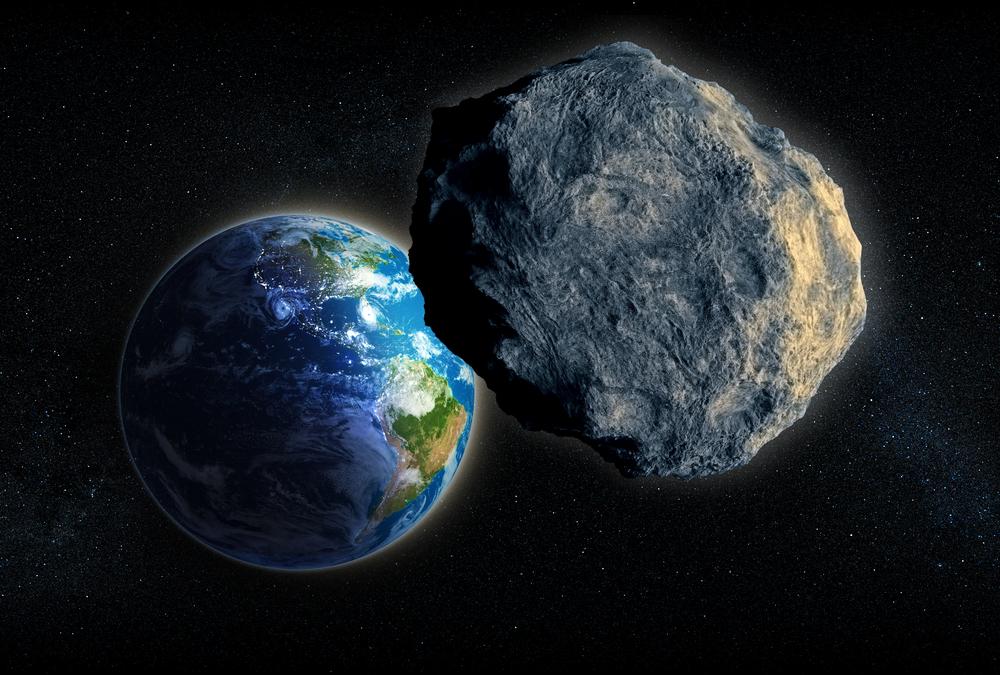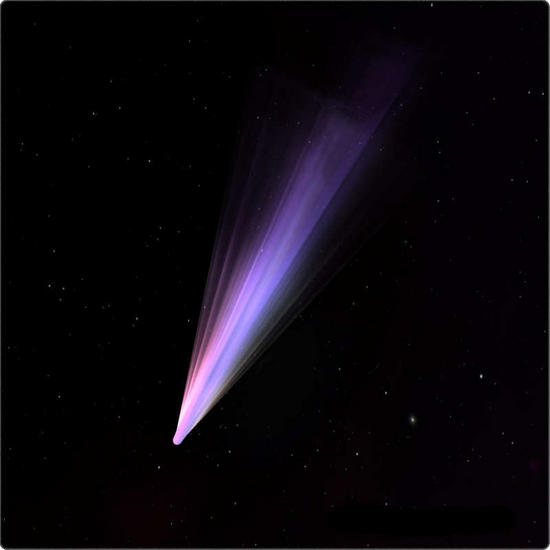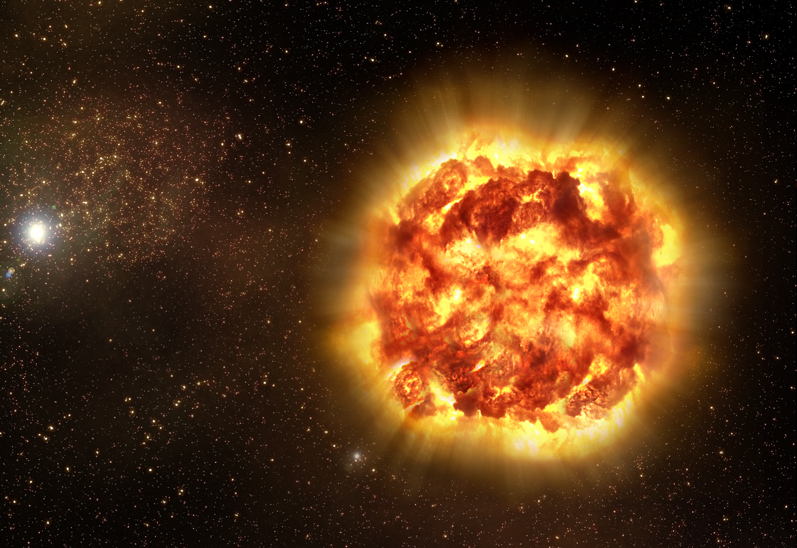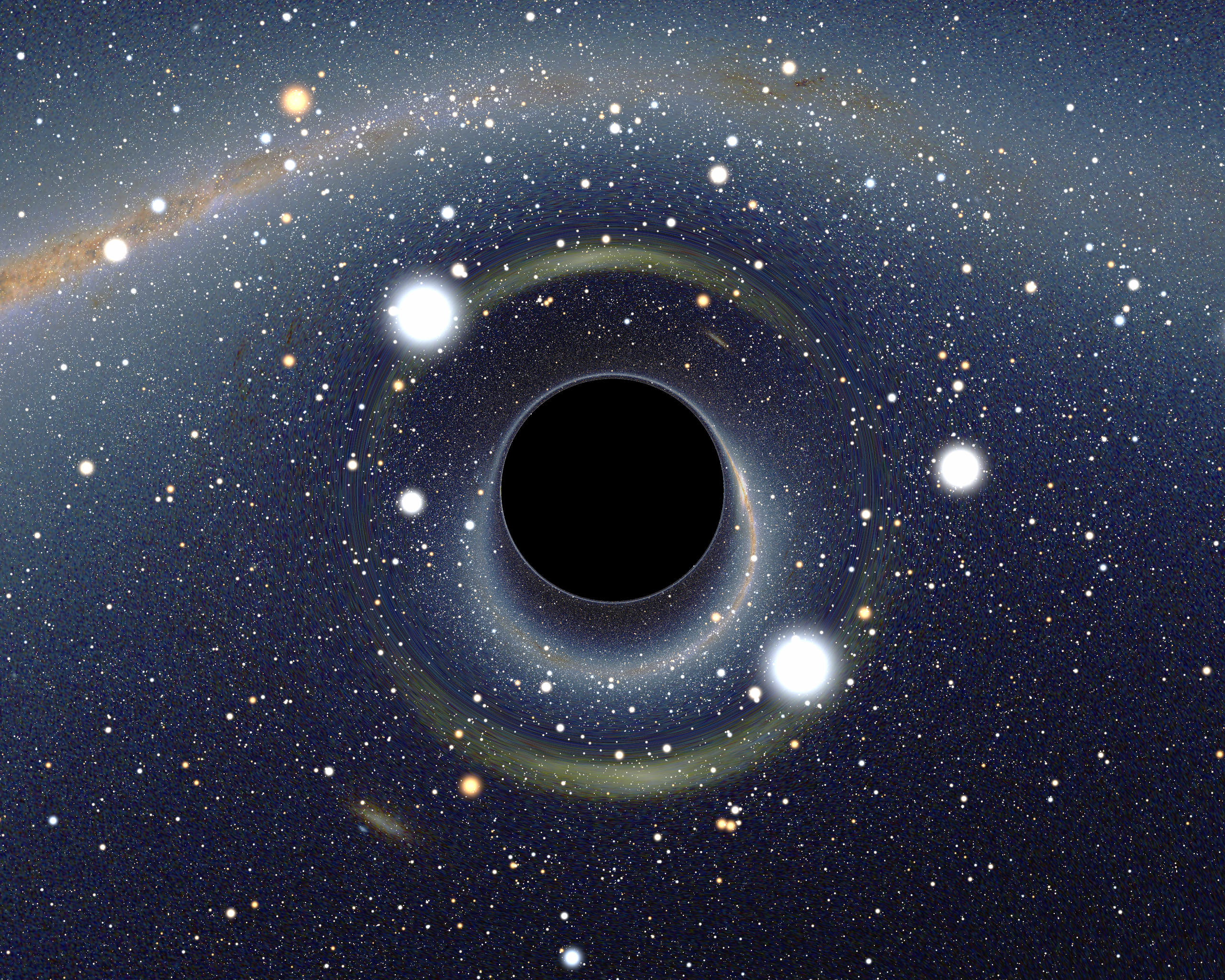Heyo Guys..
Abhishek's back with some new kicking news about the cosmos.New evidence suggests life on Earth could have started on Mars.There is a theory that's gaining a little traction in the scientific community that suggests life on Earth could have come from Mars. Evidence in favor of this theory has been building over the last couple of decades which means we... all... (could be)... Martians.
The theory basically suggests that some 4-billion years ago, life started on Mars. A meteor then struck the planet sending little chunks of Martian rocks containing Martian life into interplanetary space. One (or more) of these rocks then fell to Earth seeding life and BOOM, here you are.
This new breed of evidence comes from the Westheimer Institute for Science and Technology located in Florida after an analysis of a Martian meteorite. Today, (August 29), Prefessor Steven Benner will reveal his findings at a geochemist summit.
On the surface, the findings are pretty simply, but they have deep ramifications. The analysis of these Martian meteorites shows the presence of highly oxidized molybdenum; a substance crucial to the early development of life. According to Professor Benner, "This form of molybdenum couldn't have been available on Earth at the time life first began, because three billion years ago the surface of the Earth had very little oxygen, but Mars did. It's yet another piece of evidence which makes it more likely life came to Earth on a Martian meteorite, rather than starting on this planet."
There are a few problems with the Earth-based abiogenists theory that Benner's research hopes to address (in favor of the Martial counterpart), the so-called "tar paradox" and the RNA-water problem.
The tar paradox, a term coined by Benner, is focused on the nature of certain organic matter. When light and energy is focused onto organic molecules, and they are left to their own devices, instead of creating life, the matter turns into a tar-like substance that's not very lifelike. Some combinations of materials are none to curve or prevent this tarring to happen; boron and molybdenum are two big names here. Both of these materials were present on Mars according to the analysis of Martian meteorites which means that Mars certainly had the ingredients for life in its early history.
The second focuses on a problem with RNA and Earth's history. Most scientists now believe that life started as RNA. They also believe that Earth's early surface was completely covered in water. As standalone fun fact, that's all fine and dandy, but when you combine the two, you get problems. Firstly, boron only forms is dry places. Currently, on Earth it's only found in the driest regions of the planet, such as Death Valley. Secondly, water is corrosive to RNA, which poses a problem when life would have started in oceans as RNA.
The "life originating on Mars" idea is certainly looking more favorable the more we know about the origins of life. One day, maybe we'll be able to proudly proclaim "Yes, I am a Martian Ape!" Either way, as Prefessor Benner so eloquently put it, "It's lucky that we ended up here nevertheless, as certainly Earth has been the better of the two planets for sustaining life. If our hypothetical Martian ancestors had remained on Mars, there might not have been a story to tell."
The theory basically suggests that some 4-billion years ago, life started on Mars. A meteor then struck the planet sending little chunks of Martian rocks containing Martian life into interplanetary space. One (or more) of these rocks then fell to Earth seeding life and BOOM, here you are.
This new breed of evidence comes from the Westheimer Institute for Science and Technology located in Florida after an analysis of a Martian meteorite. Today, (August 29), Prefessor Steven Benner will reveal his findings at a geochemist summit.
On the surface, the findings are pretty simply, but they have deep ramifications. The analysis of these Martian meteorites shows the presence of highly oxidized molybdenum; a substance crucial to the early development of life. According to Professor Benner, "This form of molybdenum couldn't have been available on Earth at the time life first began, because three billion years ago the surface of the Earth had very little oxygen, but Mars did. It's yet another piece of evidence which makes it more likely life came to Earth on a Martian meteorite, rather than starting on this planet."
There are a few problems with the Earth-based abiogenists theory that Benner's research hopes to address (in favor of the Martial counterpart), the so-called "tar paradox" and the RNA-water problem.
The tar paradox, a term coined by Benner, is focused on the nature of certain organic matter. When light and energy is focused onto organic molecules, and they are left to their own devices, instead of creating life, the matter turns into a tar-like substance that's not very lifelike. Some combinations of materials are none to curve or prevent this tarring to happen; boron and molybdenum are two big names here. Both of these materials were present on Mars according to the analysis of Martian meteorites which means that Mars certainly had the ingredients for life in its early history.
The second focuses on a problem with RNA and Earth's history. Most scientists now believe that life started as RNA. They also believe that Earth's early surface was completely covered in water. As standalone fun fact, that's all fine and dandy, but when you combine the two, you get problems. Firstly, boron only forms is dry places. Currently, on Earth it's only found in the driest regions of the planet, such as Death Valley. Secondly, water is corrosive to RNA, which poses a problem when life would have started in oceans as RNA.
The "life originating on Mars" idea is certainly looking more favorable the more we know about the origins of life. One day, maybe we'll be able to proudly proclaim "Yes, I am a Martian Ape!" Either way, as Prefessor Benner so eloquently put it, "It's lucky that we ended up here nevertheless, as certainly Earth has been the better of the two planets for sustaining life. If our hypothetical Martian ancestors had remained on Mars, there might not have been a story to tell."The theory basically suggests that some 4-billion years ago, life started on Mars. A meteor then struck the planet sending little chunks of Martian rocks containing Martian life into interplanetary space. One (or more) of these rocks then fell to Earth seeding life and BOOM, here you are.This new breed of evidence comes from the Westheimer Institute for Science and Technology located in Florida after an analysis of a Martian meteorite. Today, (August 29), Prefessor Steven Benner will reveal his findings at a geochemist summit.On the surface, the findings are pretty simply, but they have deep ramifications. The analysis of these Martian meteorites shows the presence of highly oxidized molybdenum; a substance crucial to the early development of life. According to Professor Benner, "This form of molybdenum couldn't have been available on Earth at the time life first began, because three billion years ago the surface of the Earth had very little oxygen, but Mars did. It's yet another piece of evidence which makes it more likely life came to Earth on a Martian meteorite, rather than starting on this planet."There are a few problems with the Earth-based abiogenists theory that Benner's research hopes to address (in favor of the Martial counterpart), the so-called "tar paradox" and the RNA-water problem.The tar paradox, a term coined by Benner, is focused on the nature of certain organic matter. When light and energy is focused onto organic molecules, and they are left to their own devices, instead of creating life, the matter turns into a tar-like substance that's not very lifelike. Some combinations of materials are none to curve or prevent this tarring to happen; boron and molybdenum are two big names here. Both of these materials were present on Mars according to the analysis of Martian meteorites which means that Mars certainly had the ingredients for life in its early history.The second focuses on a problem with RNA and Earth's history. Most scientists now believe that life started as RNA. They also believe that Earth's early surface was completely covered in water. As standalone fun fact, that's all fine and dandy, but when you combine the two, you get problems. Firstly, boron only forms is dry places. Currently, on Earth it's only found in the driest regions of the planet, such as Death Valley. Secondly, water is corrosive to RNA, which poses a problem when life would have started in oceans as RNA.The "life originating on Mars" idea is certainly looking more favorable the more we know about the origins of life. One day, maybe we'll be able to proudly proclaim "Yes, I am a Martian Ape!" Either way, as Prefessor Benner so eloquently put it, "It's lucky that we ended up here nevertheless, as certainly Earth has been the better of the two planets for sustaining life. If our hypothetical Martian ancestors had remained on Mars, there might not have been a story to tell."The theory basically suggests that some 4-billion years ago, life started on Mars. A meteor then struck the planet sending little chunks of Martian rocks containing Martian life into interplanetary space. One (or more) of these rocks then fell to Earth seeding life and BOOM, here you are.This new breed of evidence comes from the Westheimer Institute for Science and Technology located in Florida after an analysis of a Martian meteorite. Today, (August 29), Prefessor Steven Benner will reveal his findings at a geochemist summit.On the surface, the findings are pretty simply, but they have deep ramifications. The analysis of these Martian meteorites shows the presence of highly oxidized molybdenum; a substance crucial to the early development of life. According to Professor Benner, "This form of molybdenum couldn't have been available on Earth at the time life first began, because three billion years ago the surface of the Earth had very little oxygen, but Mars did. It's yet another piece of evidence which makes it more likely life came to Earth on a Martian meteorite, rather than starting on this planet."There are a few problems with the Earth-based abiogenists theory that Benner's research hopes to address (in favor of the Martial counterpart), the so-called "tar paradox" and the RNA-water problem.The tar paradox, a term coined by Benner, is focused on the nature of certain organic matter. When light and energy is focused onto organic molecules, and they are left to their own devices, instead of creating life, the matter turns into a tar-like substance that's not very lifelike. Some combinations of materials are none to curve or prevent this tarring to happen; boron and molybdenum are two big names here. Both of these materials were present on Mars according to the analysis of Martian meteorites which means that Mars certainly had the ingredients for life in its early history.The second focuses on a problem with RNA and Earth's history. Most scientists now believe that life started as RNA. They also believe that Earth's early surface was completely covered in water. As standalone fun fact, that's all fine and dandy, but when you combine the two, you get problems. Firstly, boron only forms is dry places. Currently, on Earth it's only found in the driest regions of the planet, such as Death Valley. Secondly, water is corrosive to RNA, which poses a problem when life would have started in oceans as RNA.The "life originating on Mars" idea is certainly looking more favorable the more we know about the origins of life. One day, maybe we'll be able to proudly proclaim "Yes, I am a Martian Ape!" Either way, as Prefessor Benner so eloquently put it, "It's lucky that we ended up here nevertheless, as certainly Earth has been the better of the two planets for sustaining life. If our hypothetical Martian ancestors had remained on Mars, there might not have been a story to tell."The theory basically suggests that some 4-billion years ago, life started on Mars. A meteor then struck the planet sending little chunks of Martian rocks containing Martian life into interplanetary space. One (or more) of these rocks then fell to Earth seeding life and BOOM, here you are.This new breed of evidence comes from the Westheimer Institute for Science and Technology located in Florida after an analysis of a Martian meteorite. Today, (August 29), Prefessor Steven Benner will reveal his findings at a geochemist summit.On the surface, the findings are pretty simply, but they have deep ramifications. The analysis of these Martian meteorites shows the presence of highly oxidized molybdenum; a substance crucial to the early development of life. According to Professor Benner, "This form of molybdenum couldn't have been available on Earth at the time life first began, because three billion years ago the surface of the Earth had very little oxygen, but Mars did. It's yet another piece of evidence which makes it more likely life came to Earth on a Martian meteorite, rather than starting on this planet."There are a few problems with the Earth-based abiogenists theory that Benner's research hopes to address (in favor of the Martial counterpart), the so-called "tar paradox" and the RNA-water problem.The tar paradox, a term coined by Benner, is focused on the nature of certain organic matter. When light and energy is focused onto organic molecules, and they are left to their own devices, instead of creating life, the matter turns into a tar-like substance that's not very lifelike. Some combinations of materials are none to curve or prevent this tarring to happen; boron and molybdenum are two big names here. Both of these materials were present on Mars according to the analysis of Martian meteorites which means that Mars certainly had the ingredients for life in its early history.The second focuses on a problem with RNA and Earth's history. Most scientists now believe that life started as RNA. They also believe that Earth's early surface was completely covered in water. As standalone fun fact, that's all fine and dandy, but when you combine the two, you get problems. Firstly, boron only forms is dry places. Currently, on Earth it's only found in the driest regions of the planet, such as Death Valley. Secondly, water is corrosive to RNA, which poses a problem when life would have started in oceans as RNA.The "life originating on Mars" idea is certainly looking more favorable the more we know about the origins of life. One day, maybe we'll be able to proudly proclaim "Yes, I am a Martian Ape!" Either way, as Prefessor Benner so eloquently put it, "It's lucky that we ended up here nevertheless, as certainly Earth has been the better of the two planets for sustaining life. If our hypothetical Martian ancestors had remained on Mars, there might not have been a story to tell."The theory basically suggests that some 4-billion years ago, life started on Mars. A meteor then struck the planet sending little chunks of Martian rocks containing Martian life into interplanetary space. One (or more) of these rocks then fell to Earth seeding life and BOOM, here you are.This new breed of evidence comes from the Westheimer Institute for Science and Technology located in Florida after an analysis of a Martian meteorite. Today, (August 29), Prefessor Steven Benner will reveal his findings at a geochemist summit.On the surface, the findings are pretty simply, but they have deep ramifications. The analysis of these Martian meteorites shows the presence of highly oxidized molybdenum; a substance crucial to the early development of life. According to Professor Benner, "This form of molybdenum couldn't have been available on Earth at the time life first began, because three billion years ago the surface of the Earth had very little oxygen, but Mars did. It's yet another piece of evidence which makes it more likely life came to Earth on a Martian meteorite, rather than starting on this planet."There are a few problems with the Earth-based abiogenists theory that Benner's research hopes to address (in favor of the Martial counterpart), the so-called "tar paradox" and the RNA-water problem.The tar paradox, a term coined by Benner, is focused on the nature of certain organic matter. When light and energy is focused onto organic molecules, and they are left to their own devices, instead of creating life, the matter turns into a tar-like substance that's not very lifelike. Some combinations of materials are none to curve or prevent this tarring to happen; boron and molybdenum are two big names here. Both of these materials were present on Mars according to the analysis of Martian meteorites which means that Mars certainly had the ingredients for life in its early history.The second focuses on a problem with RNA and Earth's history. Most scientists now believe that life started as RNA. They also believe that Earth's early surface was completely covered in water. As standalone fun fact, that's all fine and dandy, but when you combine the two, you get problems. Firstly, boron only forms is dry places. Currently, on Earth it's only found in the driest regions of the planet, such as Death Valley. Secondly, water is corrosive to RNA, which poses a problem when life would have started in oceans as RNA.The "life originating on Mars" idea is certainly looking more favorable the more we know about the origins of life. One day, maybe we'll be able to proudly proclaim "Yes, I am a Martian Ape!" Either way, as Prefessor Benner so eloquently put it, "It's lucky that we ended up here nevertheless, as certainly Earth has been the better of the two planets for sustaining life. If our hypothetical Martian ancestors had remained on Mars, there might not have been a story to tell."
Heyo Guys..
Abhishek's back with some new kicking news about the cosmos.New evidence suggests life on Earth could have started on Mars.There is a theory that's gaining a little traction in the scientific community that suggests life on Earth could have come from Mars. Evidence in favor of this theory has been building over the last couple of decades which means we... all... (could be)... Martians.The theory basically suggests that some 4-billion years ago, life started on Mars. A meteor then struck the planet sending little chunks of Martian rocks containing Martian life into interplanetary space. One (or more) of these rocks then fell to Earth seeding life and BOOM, here you are.
This new breed of evidence comes from the Westheimer Institute for Science and Technology located in Florida after an analysis of a Martian meteorite. Today, (August 29), Prefessor Steven Benner will reveal his findings at a geochemist summit.
On the surface, the findings are pretty simply, but they have deep ramifications. The analysis of these Martian meteorites shows the presence of highly oxidized molybdenum; a substance crucial to the early development of life. According to Professor Benner, "This form of molybdenum couldn't have been available on Earth at the time life first began, because three billion years ago the surface of the Earth had very little oxygen, but Mars did. It's yet another piece of evidence which makes it more likely life came to Earth on a Martian meteorite, rather than starting on this planet."
There are a few problems with the Earth-based abiogenists theory that Benner's research hopes to address (in favor of the Martial counterpart), the so-called "tar paradox" and the RNA-water problem.
The tar paradox, a term coined by Benner, is focused on the nature of certain organic matter. When light and energy is focused onto organic molecules, and they are left to their own devices, instead of creating life, the matter turns into a tar-like substance that's not very lifelike. Some combinations of materials are none to curve or prevent this tarring to happen; boron and molybdenum are two big names here. Both of these materials were present on Mars according to the analysis of Martian meteorites which means that Mars certainly had the ingredients for life in its early history.
The second focuses on a problem with RNA and Earth's history. Most scientists now believe that life started as RNA. They also believe that Earth's early surface was completely covered in water. As standalone fun fact, that's all fine and dandy, but when you combine the two, you get problems. Firstly, boron only forms is dry places. Currently, on Earth it's only found in the driest regions of the planet, such as Death Valley. Secondly, water is corrosive to RNA, which poses a problem when life would have started in oceans as RNA.
The "life originating on Mars" idea is certainly looking more favorable the more we know about the origins of life. One day, maybe we'll be able to proudly proclaim "Yes, I am a Martian Ape!" Either way, as Prefessor Benner so eloquently put it, "It's lucky that we ended up here nevertheless, as certainly Earth has been the better of the two planets for sustaining life. If our hypothetical Martian ancestors had remained on Mars, there might not have been a story to tell."
The theory basically suggests that some 4-billion years ago, life started on Mars. A meteor then struck the planet sending little chunks of Martian rocks containing Martian life into interplanetary space. One (or more) of these rocks then fell to Earth seeding life and BOOM, here you are.
This new breed of evidence comes from the Westheimer Institute for Science and Technology located in Florida after an analysis of a Martian meteorite. Today, (August 29), Prefessor Steven Benner will reveal his findings at a geochemist summit.
On the surface, the findings are pretty simply, but they have deep ramifications. The analysis of these Martian meteorites shows the presence of highly oxidized molybdenum; a substance crucial to the early development of life. According to Professor Benner, "This form of molybdenum couldn't have been available on Earth at the time life first began, because three billion years ago the surface of the Earth had very little oxygen, but Mars did. It's yet another piece of evidence which makes it more likely life came to Earth on a Martian meteorite, rather than starting on this planet."
There are a few problems with the Earth-based abiogenists theory that Benner's research hopes to address (in favor of the Martial counterpart), the so-called "tar paradox" and the RNA-water problem.
The tar paradox, a term coined by Benner, is focused on the nature of certain organic matter. When light and energy is focused onto organic molecules, and they are left to their own devices, instead of creating life, the matter turns into a tar-like substance that's not very lifelike. Some combinations of materials are none to curve or prevent this tarring to happen; boron and molybdenum are two big names here. Both of these materials were present on Mars according to the analysis of Martian meteorites which means that Mars certainly had the ingredients for life in its early history.
The second focuses on a problem with RNA and Earth's history. Most scientists now believe that life started as RNA. They also believe that Earth's early surface was completely covered in water. As standalone fun fact, that's all fine and dandy, but when you combine the two, you get problems. Firstly, boron only forms is dry places. Currently, on Earth it's only found in the driest regions of the planet, such as Death Valley. Secondly, water is corrosive to RNA, which poses a problem when life would have started in oceans as RNA.
The "life originating on Mars" idea is certainly looking more favorable the more we know about the origins of life. One day, maybe we'll be able to proudly proclaim "Yes, I am a Martian Ape!" Either way, as Prefessor Benner so eloquently put it, "It's lucky that we ended up here nevertheless, as certainly Earth has been the better of the two planets for sustaining life. If our hypothetical Martian ancestors had remained on Mars, there might not have been a story to tell."The theory basically suggests that some 4-billion years ago, life started on Mars. A meteor then struck the planet sending little chunks of Martian rocks containing Martian life into interplanetary space. One (or more) of these rocks then fell to Earth seeding life and BOOM, here you are.This new breed of evidence comes from the Westheimer Institute for Science and Technology located in Florida after an analysis of a Martian meteorite. Today, (August 29), Prefessor Steven Benner will reveal his findings at a geochemist summit.On the surface, the findings are pretty simply, but they have deep ramifications. The analysis of these Martian meteorites shows the presence of highly oxidized molybdenum; a substance crucial to the early development of life. According to Professor Benner, "This form of molybdenum couldn't have been available on Earth at the time life first began, because three billion years ago the surface of the Earth had very little oxygen, but Mars did. It's yet another piece of evidence which makes it more likely life came to Earth on a Martian meteorite, rather than starting on this planet."There are a few problems with the Earth-based abiogenists theory that Benner's research hopes to address (in favor of the Martial counterpart), the so-called "tar paradox" and the RNA-water problem.The tar paradox, a term coined by Benner, is focused on the nature of certain organic matter. When light and energy is focused onto organic molecules, and they are left to their own devices, instead of creating life, the matter turns into a tar-like substance that's not very lifelike. Some combinations of materials are none to curve or prevent this tarring to happen; boron and molybdenum are two big names here. Both of these materials were present on Mars according to the analysis of Martian meteorites which means that Mars certainly had the ingredients for life in its early history.The second focuses on a problem with RNA and Earth's history. Most scientists now believe that life started as RNA. They also believe that Earth's early surface was completely covered in water. As standalone fun fact, that's all fine and dandy, but when you combine the two, you get problems. Firstly, boron only forms is dry places. Currently, on Earth it's only found in the driest regions of the planet, such as Death Valley. Secondly, water is corrosive to RNA, which poses a problem when life would have started in oceans as RNA.The "life originating on Mars" idea is certainly looking more favorable the more we know about the origins of life. One day, maybe we'll be able to proudly proclaim "Yes, I am a Martian Ape!" Either way, as Prefessor Benner so eloquently put it, "It's lucky that we ended up here nevertheless, as certainly Earth has been the better of the two planets for sustaining life. If our hypothetical Martian ancestors had remained on Mars, there might not have been a story to tell."The theory basically suggests that some 4-billion years ago, life started on Mars. A meteor then struck the planet sending little chunks of Martian rocks containing Martian life into interplanetary space. One (or more) of these rocks then fell to Earth seeding life and BOOM, here you are.This new breed of evidence comes from the Westheimer Institute for Science and Technology located in Florida after an analysis of a Martian meteorite. Today, (August 29), Prefessor Steven Benner will reveal his findings at a geochemist summit.On the surface, the findings are pretty simply, but they have deep ramifications. The analysis of these Martian meteorites shows the presence of highly oxidized molybdenum; a substance crucial to the early development of life. According to Professor Benner, "This form of molybdenum couldn't have been available on Earth at the time life first began, because three billion years ago the surface of the Earth had very little oxygen, but Mars did. It's yet another piece of evidence which makes it more likely life came to Earth on a Martian meteorite, rather than starting on this planet."There are a few problems with the Earth-based abiogenists theory that Benner's research hopes to address (in favor of the Martial counterpart), the so-called "tar paradox" and the RNA-water problem.The tar paradox, a term coined by Benner, is focused on the nature of certain organic matter. When light and energy is focused onto organic molecules, and they are left to their own devices, instead of creating life, the matter turns into a tar-like substance that's not very lifelike. Some combinations of materials are none to curve or prevent this tarring to happen; boron and molybdenum are two big names here. Both of these materials were present on Mars according to the analysis of Martian meteorites which means that Mars certainly had the ingredients for life in its early history.The second focuses on a problem with RNA and Earth's history. Most scientists now believe that life started as RNA. They also believe that Earth's early surface was completely covered in water. As standalone fun fact, that's all fine and dandy, but when you combine the two, you get problems. Firstly, boron only forms is dry places. Currently, on Earth it's only found in the driest regions of the planet, such as Death Valley. Secondly, water is corrosive to RNA, which poses a problem when life would have started in oceans as RNA.The "life originating on Mars" idea is certainly looking more favorable the more we know about the origins of life. One day, maybe we'll be able to proudly proclaim "Yes, I am a Martian Ape!" Either way, as Prefessor Benner so eloquently put it, "It's lucky that we ended up here nevertheless, as certainly Earth has been the better of the two planets for sustaining life. If our hypothetical Martian ancestors had remained on Mars, there might not have been a story to tell."The theory basically suggests that some 4-billion years ago, life started on Mars. A meteor then struck the planet sending little chunks of Martian rocks containing Martian life into interplanetary space. One (or more) of these rocks then fell to Earth seeding life and BOOM, here you are.This new breed of evidence comes from the Westheimer Institute for Science and Technology located in Florida after an analysis of a Martian meteorite. Today, (August 29), Prefessor Steven Benner will reveal his findings at a geochemist summit.On the surface, the findings are pretty simply, but they have deep ramifications. The analysis of these Martian meteorites shows the presence of highly oxidized molybdenum; a substance crucial to the early development of life. According to Professor Benner, "This form of molybdenum couldn't have been available on Earth at the time life first began, because three billion years ago the surface of the Earth had very little oxygen, but Mars did. It's yet another piece of evidence which makes it more likely life came to Earth on a Martian meteorite, rather than starting on this planet."There are a few problems with the Earth-based abiogenists theory that Benner's research hopes to address (in favor of the Martial counterpart), the so-called "tar paradox" and the RNA-water problem.The tar paradox, a term coined by Benner, is focused on the nature of certain organic matter. When light and energy is focused onto organic molecules, and they are left to their own devices, instead of creating life, the matter turns into a tar-like substance that's not very lifelike. Some combinations of materials are none to curve or prevent this tarring to happen; boron and molybdenum are two big names here. Both of these materials were present on Mars according to the analysis of Martian meteorites which means that Mars certainly had the ingredients for life in its early history.The second focuses on a problem with RNA and Earth's history. Most scientists now believe that life started as RNA. They also believe that Earth's early surface was completely covered in water. As standalone fun fact, that's all fine and dandy, but when you combine the two, you get problems. Firstly, boron only forms is dry places. Currently, on Earth it's only found in the driest regions of the planet, such as Death Valley. Secondly, water is corrosive to RNA, which poses a problem when life would have started in oceans as RNA.The "life originating on Mars" idea is certainly looking more favorable the more we know about the origins of life. One day, maybe we'll be able to proudly proclaim "Yes, I am a Martian Ape!" Either way, as Prefessor Benner so eloquently put it, "It's lucky that we ended up here nevertheless, as certainly Earth has been the better of the two planets for sustaining life. If our hypothetical Martian ancestors had remained on Mars, there might not have been a story to tell."The theory basically suggests that some 4-billion years ago, life started on Mars. A meteor then struck the planet sending little chunks of Martian rocks containing Martian life into interplanetary space. One (or more) of these rocks then fell to Earth seeding life and BOOM, here you are.This new breed of evidence comes from the Westheimer Institute for Science and Technology located in Florida after an analysis of a Martian meteorite. Today, (August 29), Prefessor Steven Benner will reveal his findings at a geochemist summit.On the surface, the findings are pretty simply, but they have deep ramifications. The analysis of these Martian meteorites shows the presence of highly oxidized molybdenum; a substance crucial to the early development of life. According to Professor Benner, "This form of molybdenum couldn't have been available on Earth at the time life first began, because three billion years ago the surface of the Earth had very little oxygen, but Mars did. It's yet another piece of evidence which makes it more likely life came to Earth on a Martian meteorite, rather than starting on this planet."There are a few problems with the Earth-based abiogenists theory that Benner's research hopes to address (in favor of the Martial counterpart), the so-called "tar paradox" and the RNA-water problem.The tar paradox, a term coined by Benner, is focused on the nature of certain organic matter. When light and energy is focused onto organic molecules, and they are left to their own devices, instead of creating life, the matter turns into a tar-like substance that's not very lifelike. Some combinations of materials are none to curve or prevent this tarring to happen; boron and molybdenum are two big names here. Both of these materials were present on Mars according to the analysis of Martian meteorites which means that Mars certainly had the ingredients for life in its early history.The second focuses on a problem with RNA and Earth's history. Most scientists now believe that life started as RNA. They also believe that Earth's early surface was completely covered in water. As standalone fun fact, that's all fine and dandy, but when you combine the two, you get problems. Firstly, boron only forms is dry places. Currently, on Earth it's only found in the driest regions of the planet, such as Death Valley. Secondly, water is corrosive to RNA, which poses a problem when life would have started in oceans as RNA.The "life originating on Mars" idea is certainly looking more favorable the more we know about the origins of life. One day, maybe we'll be able to proudly proclaim "Yes, I am a Martian Ape!" Either way, as Prefessor Benner so eloquently put it, "It's lucky that we ended up here nevertheless, as certainly Earth has been the better of the two planets for sustaining life. If our hypothetical Martian ancestors had remained on Mars, there might not have been a story to tell."

























.jpg)
.jpg)
.jpg)

.jpg)
.jpg)
.jpg)
.jpg)
.jpg)
.jpg)
.jpg)






.jpg)

.jpg)

